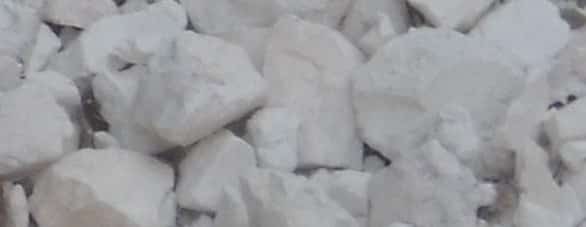Menu

Industrial Minerals:
Kaolin is a hydrated aluminum silicate (approximately H2Al2Si2O8-H2O) obtained by mining naturally occurring a layered silicate mineral deposits. The name is taken from Kao-ling (in Chinese:,high ridge), the original place. Kaolin samples were first sent to Europe by a French missionaries around 1700 as an example of the materials used by the Chinese in the manufacture of chinaware.Kaolin is an odorless white to yellowish or grayish powder. It is crushed and released from big and rough particles either by classifying or by screening. Foreign matters often found associated with the crude mineral like ferric oxide, calcium carbonate, and magnesium carbonate are removed with an electro-magnet and by treatment with hydrochloric acid or sulfuric acids. Kaoline is not soluble in water but darkens and causes an earthy smell when it is wet. As its essential constituent is a fine grained white clay, this makes it ideal for a selection of industrial applications. Its melting point is 740-1785 °C and density 2,65 g/cm3.
Kaolin deposits could be classified into two kinds, primary (residual) and secondary (sedimentary). Processed high-quality kaolins are majorly used for specific applications in paper, ceramics and refractories, plastics, rubber, adhesives and paint industries. Metakaolin is the dehydroxylated form of the clay mineral kaolinite that is calcined under controlled temperatures to create an amorphous aluminosilicate that can be used in concrete and mortar applications. Crude kaolin is usually yellow dotted yellow by iron hydroxide pigments. It is often necessary to bleach the clay chemically to remove the iron pigment and to wash it with water to extract the other minerals in order to make kaolin ready for commercial use.
When it is mixed with water in the range of 20 percent around Kaolin becomes plastic and can be molded under pressure, and the shape is kept after the pressure is withdrawn. With larger percentages of water, the kaolin forms a slurry suspension. The amount of water required to achieve plasticity and viscosity differs with the size of the kaolinite particles and also with certain chemicals in the kaolin.
In paper industry, it is mixed with the cellulose fibre and gives the paper sheet body, colour, opacity and printability. In coating, it is covered together with an adhesive on the paper’s surface to give gloss, colour, high opacity, and greater printability.
In the ceramic industry, it is suitable against the high fusion temperature and white burning characteristics makes it particularly suitable for producing chinaware, porcelain, and refractories. These character of kaolin is necessary to obtain the necessary properties of plasticity, shrinkage, vitrification for forming and firing the ware. It is generally used on its own in the manufacture of refractories.
Large amount of kaolin is used for filling rubber to improve its mechanical strength and resistance to abrasion. Hence, the clay must be extremely pure kaolinite and fine grained very well. Kaolin is also used as an extender and flattening agent in paints. It is frequently used in adhesives for paper to control the penetration into the paper. Kaolin plays an important role in ink, organic plastics, some cosmetics, and many other products due to having very fine particle size, whiteness, chemical inertness, and absorption properties.
APPLICATIONS
Paper
Ceramics & Tiles
Sanitary wares
Abrasives
Fillers
Paints & pigments
Adhesives and sealant chemicals
Fiberglass
Rubber
Plastics
Cement
Organic farming
Waste water treatment
Refractories
White cement & Concrete
Mortar
Shotcrete
Geopolymers
Cable Insulation
Specialty films
Fertilizers
Pesticides
Fuels and Fuel additives
Process regulators
Viscosity adjustors
Automotive care products
Cosmetic & Personal care products
Pharmaceuticals